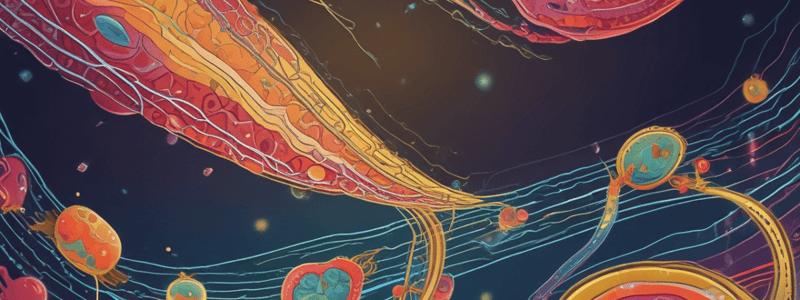Podcast
Questions and Answers
What is the role of ATP concentration in regulating electron transport and ATP synthesis?
What is the role of ATP concentration in regulating electron transport and ATP synthesis?
- It increases the ADP concentration
- It stops the ATP synthase when it is low
- It has no effect on both processes
- It regulates both processes by controlling proton pumping (correct)
What happens when ATP concentration is high in the mitochondria?
What happens when ATP concentration is high in the mitochondria?
- ATP synthase stops due to lack of substrate (correct)
- Proton pumping to the outside increases
- H+ transport back into the mitochondria increases
- Electron transport increases
What is the effect of uncouplers on the electron transport and ATP synthesis?
What is the effect of uncouplers on the electron transport and ATP synthesis?
- They increase the ATP production
- They decrease the proton pumping
- They uncouple the two processes, dissipating the proton motive force as heat (correct)
- They have no effect on the two processes
What is the significance of proton leak in the mitochondria?
What is the significance of proton leak in the mitochondria?
What is the function of uncoupling proteins (UCPs) in the mitochondria?
What is the function of uncoupling proteins (UCPs) in the mitochondria?
What is the role of UCP1 in the mitochondria?
What is the role of UCP1 in the mitochondria?
What is the outcome of stage 1 of catabolism?
What is the outcome of stage 1 of catabolism?
What is the result of uncoupling electron transport and ATP synthesis?
What is the result of uncoupling electron transport and ATP synthesis?
What is the purpose of the electron transport system?
What is the purpose of the electron transport system?
What is the result of the complete oxidation of glucose?
What is the result of the complete oxidation of glucose?
What happens to the C-C bonds and C-atoms by the end of stage 3?
What happens to the C-C bonds and C-atoms by the end of stage 3?
What is the net ATP produced in oxidative phosphorylation?
What is the net ATP produced in oxidative phosphorylation?
What is the byproduct of the electron transport system?
What is the byproduct of the electron transport system?
What is the stage of catabolism where Acetyl-CoA is metabolized to CO₂ and formation of ATP occurs?
What is the stage of catabolism where Acetyl-CoA is metabolized to CO₂ and formation of ATP occurs?
What is QUCP2 linked to?
What is QUCP2 linked to?
Where is QUCP3 mainly found?
Where is QUCP3 mainly found?
What is the function of noradrenaline?
What is the function of noradrenaline?
What is produced as a result of ẞ-oxidation of fatty acids?
What is produced as a result of ẞ-oxidation of fatty acids?
What is the effect of noradrenaline on UCP1?
What is the effect of noradrenaline on UCP1?
What happens to the higher p.m.f. generated by NADH and FAD2H?
What happens to the higher p.m.f. generated by NADH and FAD2H?
What is the purpose of UCP1 in brown adipose tissue?
What is the purpose of UCP1 in brown adipose tissue?
What is the effect of anaerobic conditions on electron transport?
What is the effect of anaerobic conditions on electron transport?
What is the result of electron transport inhibition?
What is the result of electron transport inhibition?
What is required for oxidative phosphorylation to occur?
What is required for oxidative phosphorylation to occur?
What is the primary process for ATP synthesis in cells that require large amounts of energy?
What is the primary process for ATP synthesis in cells that require large amounts of energy?
What is the energy coupling mechanism in oxidative phosphorylation?
What is the energy coupling mechanism in oxidative phosphorylation?
What is the consequence of irreversible cell damage?
What is the consequence of irreversible cell damage?
What is the effect of carbon monoxide on electron transport?
What is the effect of carbon monoxide on electron transport?
What is the result of the energy released from the breaking of bonds in glycolysis and the TCA cycle?
What is the result of the energy released from the breaking of bonds in glycolysis and the TCA cycle?
What is the function of NADH and FAD2H in oxidative phosphorylation?
What is the function of NADH and FAD2H in oxidative phosphorylation?
What is the outcome of the oxidation of NADH and FAD2H?
What is the outcome of the oxidation of NADH and FAD2H?
What is the site of oxidative phosphorylation?
What is the site of oxidative phosphorylation?
What is the role of electron transport in oxidative phosphorylation?
What is the role of electron transport in oxidative phosphorylation?
What is the purpose of ATP synthesis in oxidative phosphorylation?
What is the purpose of ATP synthesis in oxidative phosphorylation?
What is the change in Gibbs free energy (ΔG°) for the oxidation of NADH?
What is the change in Gibbs free energy (ΔG°) for the oxidation of NADH?




